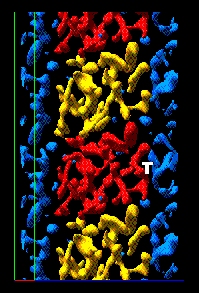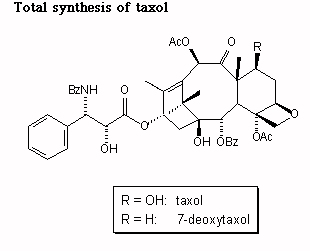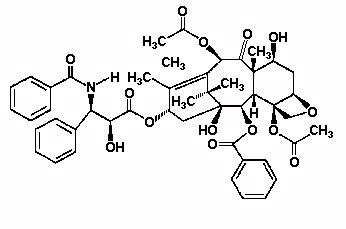
Taxol's binding domain has been narrowed down to a 31 amino acid sequence and this important peptide fragment has been probed for structural information using multidimensional NMR spectroscopy. This structural characterisation of the Taxol binding site within [[beta]]-tubulin could lead to the design and synthesis of improved successors to Taxol. Additionally, knowing the exact binding site for Taxol will encourage new approaches to attack the very popular problem of the development of Taxol resistance to human tumors. Below is an image indicating where taxol is thought to bind:

The functional group of the drug Taxol is contained in the compound's core. It consists of 20 carbon atoms arranged in three linked rings. A chain of atoms extends from one ring, and other atoms make a square formation off of another ring forming a forth ring. Taxol can also be synthesized using pinene, an ingredient in turpentine from pine extract, or from cedar oil using the same process. This process contains approximately 13 steps, but has proven ineffective so far because synthesis of the third ring is still in effect. The European Yew also has a compound resembling Taxol but the core molecule that characterizes Taxol is bent around the binding site creating a cone formation. The molecule must be modified using a semi-synthetic process in order to obtain the straight configuration that is active against tumors. This is done fairly easily but the European Yew is also scarce. The goal of researchers is to pinpoint the structure that makes Taxol an anti-cancer drug and synthesize that compound. "Prodrug's" are also being investigated in the search for anti-cancer drugs. Once ingested these drugs convert to the substance Taxol and have the same effects on cells.
As taxol is still a relatively new discovery, there are many important factors about it which are unknown. This means that the on-going research is at the cutting edge of scientific knowledge and possible syntheses for taxol are tentative and varied. Those who feel they may have succeeded are keeping it close to their chests, possibly in search of a patent. Some research groups have been successful in synthesising Taxol, one being at Glaxo-Wellcome, however, due to the complexity and length of the process they have proven to not be industrially viable. It looks as though Taxol derivatives will have to be the way forward, this or using cell-cultures. Below are a few partial syntheses of taxol.

This synthesis relies on novel ways of utilizing natural terpenoids as chiral educts in the synthesis. An efficient method has already been developed, capable of large scale production of verbenone in one step from inexpensive commercial products. For the synthesis of the taxol side chain, or its structural modifications, a powerful route utilizing the Sharpless asymmetric dihydroxylation chemistry has been developed. This has been achieved by synthesis of the A-ring subunit using two alternative routes, and an enantioselective synthesis of the C-ring fragment has been finished. Model studies for the formation of the oxetane ring (CD-unit) using a novel rearrangement have been successfully completed, and the coupling of the units has been initiated.
Another possible synthesis is outlined below.

A group from Leicester used a protected glucose methyl ketone as a starting material for their synthesis. The compond is readily obtained from glucose and has a necklace of asymmetric centers. The route preserves the chirality of the glucose ring right through the taxol molecule.
The initial part of the group's strategy was to convert the sugar ring to the carbocyclic C ring of the taxol structure. In 1991, the researchers subjected the glucose derivative to annulation to produce a tricyclic enone. This was the first reported application of this annulation reaction to the synthesis of annulated sugars.
At a meeting in Dublin the group announced that they had recently taken the glucose-to-taxol synthesis an important stage further by constructing a taxoid C ring attached to a diene. "We now plan to construct dienophiles and then use the intramolecular Diels-Alder reaction to produce the A and B rings of the taxoid structure."
For a synthesis of enantiomerically pure C8-Desmethyl C, D-ring portion of Taxol via asymmetric Diels-Alder reaction of 2-siloxyfuran, with reaction scheme, click here.